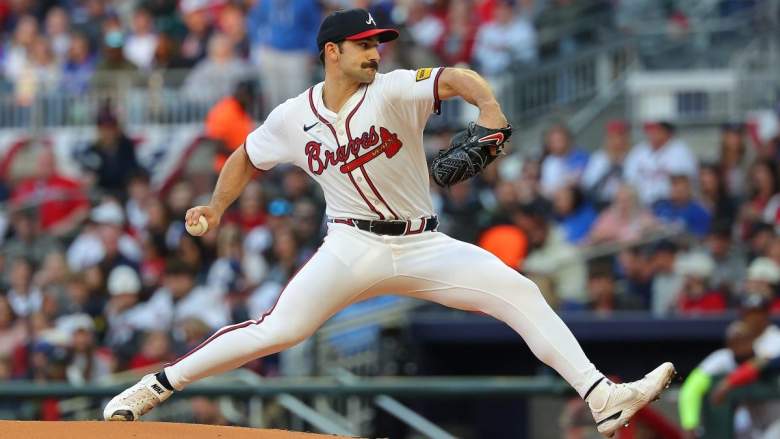
Getty Spencer Strider
An unprecedented number of top MLB pitchers have already found themselves on the injured list, with one star referring to an “injury epidemic.” Meanwhile, the MLB Players Association is pointing the blame in one direction — the pitch clock.
“Despite unanimous Player opposition and significant concerns regarding health and safety, the Commissioner’s Office reduced the length of the Pitch Clock last December, just one season removed from imposing the most significant rule change in decades,” the union’s executive director, Tony Clark, wrote in a statement issued April 6. “Since then, our concerns about the health impacts of reduced recovery time have only intensified.”
The statement, posted on X, continued: “The league’s unwillingness thus far to acknowledge or study the effects of these profound changes is an unprecedented threat to our game and its most valuable asset — the Players.”
Just hours later, MLB released a statement responding to the MLBPA, rejecting their assertion that the pitch clock was to blame for the increase in pitcher injuries, instead pointing to the increases in pitch velocity and spin seen across the majors.
“[The MLBPA’s] statement ignores the empirical evidence and much more significant long-term trend, over multiple decades, of velocity and spin increases that are highly correlated with arm injuries,” MLB’s statement read.
“Nobody wants to see pitchers get hurt in this game, which is why MLB is currently undergoing a significant comprehensive research study into the causes of this long-term increase, interviewing prominent medical experts across baseball which to date has been consistent with an independent analysis by Johns Hopkins University that found no evidence to support that the introduction of the pitch clock has increased injuries.”
The analysis by Johns Hopkins University being referenced by MLB is not available to the public.
Top Pitchers Gerrit Cole & Spencer Strider Are Among Those Injured
In one 48-hour period in Week 2 of the 2024 season, pitchers Eury Pérez (Miami Marlins), Shane Bieber (Cleveland Guardians) and Spencer Strider (Atlanta Braves) all suffered elbow injuries, with Pérez and Bieber both ruled out for the rest of the season. New York Yankees reliever Jonathan Loáisiga’s season is also finished due to a torn elbow ligament, while Gerrit Cole (Yankees) and Framber Valdez (Houston Astros) are currently on the IL due to nerve inflammation and elbow soreness, respectively.
In February, Strider told USA Today’s Gabe Lacques that “there’s an injury epidemic in the game.” Since making the statement, Strider has landed on the IL with a damaged UCL.
“If anything,” Strider said, “the league is making rule changes despite an injury epidemic that could very well be encouraging injuries, such as the pitch clock, limiting the number of pitchers on roster, how many pitching changes you can make, how many mound visits you can have. All those things are making pitching harder and potentially, I think, making health more difficult to manage.”
After testing the pitch clock in the minor leagues, MLB introduced it to the majors before the 2023 season, limiting the time a pitcher can use before he throws the ball to the hitter, as well as limiting the time a hitter can use before being in the batter’s box and prepared to hit. Before this season, the pitch clock time was reduced further, resulting in a number of pitchers expressing concern about the potential for injuries.
Rate of Pitcher Injuries Has Been Steadily Rising
According to researcher Jon Roegele, 34.2% of pitchers to appear in a MLB game in 2023 had Tommy John surgery at some point in their past, compared to 34.0% in 2022, 30.5% in 2021, and 29.8% in 2019. While pitcher elbow and shoulder injuries have always been an unfortunate part of baseball, the number has been going up quickly over the last few years.
While the MLBPA’s statement focused solely on the pitch clock, there are undeniably other factors at play.
According to Statcast and reported by CBS Sports’ Mike Axisa, the average MLB fastball velocity in April 2024 is 94.0 mph, compared to just 92.6 mph in April 2015. The spin on breaking balls has also increased from 2,156 rpm in April 2015 to 2,458 rpm this season.
On April 7, Astros starter Justin Verlander told KPRC2’s Ari Alexander, “I think the game has changed a lot.”
“It would be easiest to blame the pitch clock, [but] in reality you put everything together and everything has a little bit of influence,” Verlander said. “Everybody is throwing as hard as they possibly can and spinning the ball as hard as they possibly can.”
Regardless of whether it’s the pitch clock, velocity, spin, a combination of the three or something else entirely, the issue of pitcher injuries in MLB is undeniably one that needs to be addressed.
“I just hope that we don’t wait too long,” Verlander said. “It’s a pandemic and it’s going to take years to work itself out.”